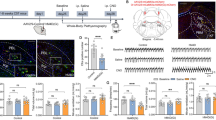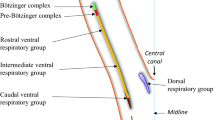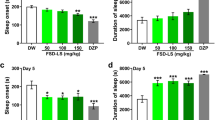Abstract
The nitric oxide (NO) synthase inhibitor NG-monomethyl-L-arginine (N-NMMA) and the competitive substrate for NO synthase L-arginine were used to determine the role of endogenous NO on the behavioral and neuroendocrine responsiveness following systemic corticotrophin in dexamethasone-suppressed rats. Corticotrophin (50-200 mU/kg, s.c.) dose-dependently decreased behavioral activity in the actimeter and produced significant anxiolytic and anti-risk activity in the plus-maze behavior test, without affecting systolic blood pressure. Rats given corticotrophin showed significant increased plasma corticosterone and reduced adrenal ascorbic acid level. These behavioral and adrenal responses of corticotrophin were dose dependently blocked by metyrapone (20 and 50 mg/kg, i.p.), an inhibitor of steroid 11β-hydroxylase in adrenal and neural tissues that block steroidogenesis. Intracerebroventricular administration of L-NMMA (20 μg/rat in 10 μl) significantly prevented the behavioral hypoactivity and anxiolytic-like responses of corticotrophin without influencing the adrenal responsiveness. The effect of L-NMMA was completely reversed by preadministration of L-arginine (300 mg/kg, i.p.). These results suggest that neuronal nitric oxide pathway plays an important modulating role in the behavioral effects of corticotrophin by mechanisms other than those involving cardiovascular effects.
Similar content being viewed by others
References
Moncada S, Palmer RMJ, Higgs EA: Nitric oxide: Physiology, pathophysiology, and pharmacology. Pharmacol Rev 43: 109–142, 1991
Palmer RMJ, Ferrige AG, Moncada S: Nitric oxide release accounts for biological activity of endothelium-derived relaxing factor. Nature 327: 524–526, 1987
Reddy DS, Singh M, Chopra K: Signalling mechanisms of cardiac hypertrophy. Ind J Pharmacol 28: 58–71, 1996
Rees DD, Palmer RMJ, Schulz R, Hodson HF, Moncada S: Characterization of three inhibitors of endothelial nitric oxide synthase in vitro and in vivo. Br J Pharmacol 101: 746–752, 1990
Brignola G, Calignano A, Rosa MD: Modulation of morphine antinociception in the mouse by endogenous nitric oxide. Br J Pharmacol 133: 1372–1376, 1994
Garthwiate J: Glutamate, nitric oxide and cell signalling in the nervous system. Trends Neurosci 14: 60–67, 1991
Bredt DS, Hwang, PM, Snyder SH: Localization of nitric oxide synthase indicating a neural role for nitric oxide. Nature 347: 768–770, 1990
Meller ST, Dykstra C, Gebhart GF: Production of endogenous nitric oxide and activation of soluble guanylate cyclase are required for Nmethyl-D-aspartate-produced facilitation of the nociceptive tail-flick reflex. Eur J Pharmacol 214: 93–96, 1992
Bredt DS, Snyder SH: Isolation of nitric oxide synthetase, a calmodulinrequiring enzyme. Proc Natl Acad Sci USA 87: 682–685, 1990
Garthwaite J, Garthwaite G, Palmer RMJ, Moncada S: NMDA receptor activation induces nitric oxide synthesis from arginine from rat brain slices. Eur J Pharmacol 172: 413–416, 1989
Miki N, Kawabe Y, Kuriyama K: Activation of cerebral guanylate cyclase by nitric oxide. Biochem Biophys Res Commun 75: 815–856, 1991
Lonart G, Wang J, Johnson KM: Nitric oxide induces neurotransmitter release from hippocampal slices. Eur J Pharmacol 220: 271–272, 1992
Hanbauer I, Win D, Osawa Y, Edelman GM, Gally JA: Role of nitric oxide in NMDA-evoked release of 3H-dopamine from striatal slices. NeuroReport 3: 409–412, 1992
Dawson VL, Dawson, TM, London ED, Bredt DS, Snyder SH: Nitric oxide mediates glutamate neurotoxicity in primary cortical cultures. Proc Natl Acad Sci USA 88: 6368–6371, 1991
Schuman EM, Madison DV: A requirement for the intercellular messenger nitric oxide in long-term potentiation. Science 254: 1503–1506, 1991.
Sandi C, Guaza C: Evidence for nitric oxide-mediated rapid locomotor effects of corticosterone in a novel environment. Ann NY Acad Sci 756: 398–399, 1994
Sandi C, Venero C, Guaza C: Nitric oxide synthesis inhibitors prevent rapid behavioral effects of corticosterone in rats. Neuroendocrinology 63: 446–453, 1996
DeWied D, Jolles J: Neuropeptides derived from the pro-opiocortin: Behavioral, physiological and neurochemical effects. Physiol Rev 62: 976–1059, 1982
Pranzatelli MR: On the molecular mechanism of adrenocorticotrophic hormone in the CNS: Neurotransmitters and receptors. Exp Neurol 125: 142–161, 1994
Baram TZ, Schultz L: ACTH does not control neonatal seizures induced by administration of exogenous corticotropin-releasing hormone. Epilepsia 36: 174–178, 1995
Snead OC, Benton JW, Hosey LC, et al.: Treatment of infantile spasms with high-dose ACTH: Efficacy and plasma levels of ACTH and prednisone. Neurology 39: 1027–1031, 1989
Hol T, Spruijt BM: The MSH/ACTH (4-9) analog ORG 2766 counteracts isolation-induced changes in social behavior via the amygdala. Peptides 13: 541–544, 1991
Niesink RJM, Van Ree JM: Normalizing effects of an ACTH 4-9 analog (ORG 2766) on ‘disturbed’ social behavior of rats: Implication of endogenous opioid systems. Science 221: 960–962, 1983
Kulkarni SK, Reddy DS: Neurosteroids: A new class of neuromodulators. Drugs Today 31: 433–455, 1995
Reddy DS, Kulkarni SK: Role of GABA-A and mitochondrial diazepam binding inhibitor receptors in the antistress activity of neurosteroids in mice. Psychopharmacology 128: 280–292, 1996
Reddy DS, Kulkarni SK: Differential anxiolytic effects of neurosteroids in the mirrored chamber behavior test in mice. Brain Res 752: 61–71, 1997
Reddy DS, Kulkarni SK: Neurosteroid co-administration prevents development of tolerance and augments recovery from chronic benzodiazepine withdrawal anxiety and hyperactivity in mice. Meth Find Exp Clin Pharmacol 19: 395–405, 1997
Kulkarni SK, Reddy DS: Animal behavioral models for testing antianxiety agents. Meth Find Exp Clin Pharmacol 18: 219–230, 1996
Griebel G, Sanger DJ, Perrault G: The use of the rat elevated plus-maze to discriminate between non-selective and BZ-1 (ω1) selective, benzodiazepine receptor ligands. Psychopharmacology 124: 245–254, 1996
Reddy DS, Singh M, Ghosh S, Ganguly NK: Role of cardiac reninangiotensin system in the development of pressure-overload left ventricular hypertrophy in rats with abdominal aortic constriction. Mol Cell Biochem 155: 1–11, 1996
James VHT, Mattingly D, Daly JR: Recommended method for the determination of plasma corticosteroids. Brit Med J 197: 310–313, 1971
DeWied D, Ferrari W (eds). Central actions of ACTH and related peptides. Padova: Fidia Research Series, 1986
Jain MR, Patil PP, Subhedar N: Intracranial metyrapone stimulates CRFACTH axis in the teleost, Clarias batrachus: Possible role of neurosteroids. NeuroReport 5: 2093–2096, 1994
Jain MR, Patil PP, Subhedar N: Direct action of metyrapone on brain: Implication in feeding. NeuroReport 5: 69–71, 1993
Weber DM, Eke BC, Maines MD: Corticosterone regulates heme oxygenase-2 and NO synthase transcription and protein expression in rat brain. J Neurochem 63: 953–62, 1994
Author information
Authors and Affiliations
Rights and permissions
About this article
Cite this article
Reddy, D.S., Kulkarni, S.K. Inhibition of neuronal nitric oxide synthase (n-cNOS) reverses the corticotrophin-induced behavioral effects in rats. Mol Cell Biochem 183, 25–38 (1998). https://doi.org/10.1023/A:1006815125689
Issue Date:
DOI: https://doi.org/10.1023/A:1006815125689




